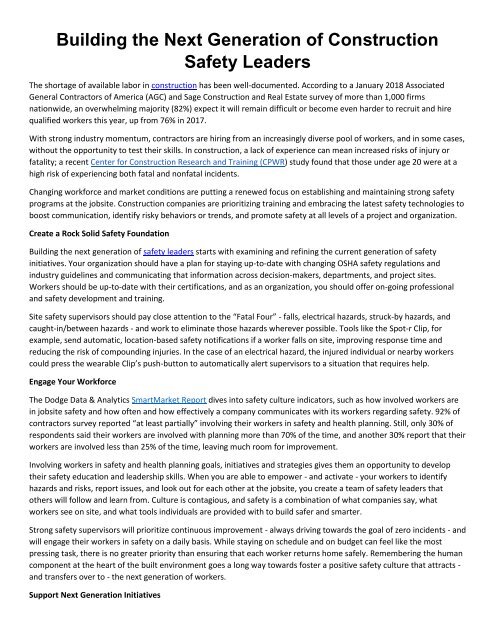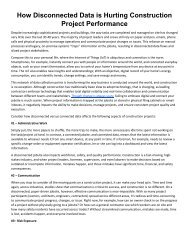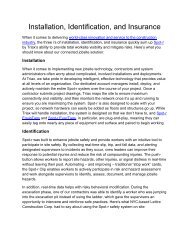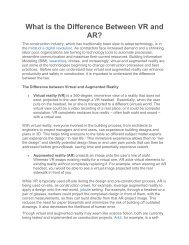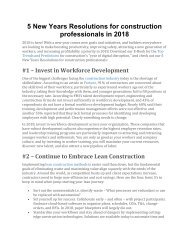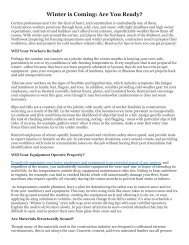Building the Next Generation of Construction Safety Leaders
The shortage of available labor in construction has been well-documented. According to a January 2018 Associated General Contractors of America (AGC) and Sage Construction and Real Estate survey of more than 1,000 firms nationwide, an overwhelming majority (82%) expect it will remain difficult or become even harder to recruit and hire qualified workers this year, up from 76% in 2017. Visit: https://www.triaxtec.com/workersafety/
The shortage of available labor in construction has been well-documented. According to a January 2018 Associated General Contractors of America (AGC) and Sage Construction and Real Estate survey of more than 1,000 firms nationwide, an overwhelming majority (82%) expect it will remain difficult or become even harder to recruit and hire qualified workers this year, up from 76% in 2017. Visit: https://www.triaxtec.com/workersafety/
You also want an ePaper? Increase the reach of your titles
YUMPU automatically turns print PDFs into web optimized ePapers that Google loves.
<strong>Building</strong> <strong>the</strong> <strong>Next</strong> <strong>Generation</strong> <strong>of</strong> <strong>Construction</strong><br />
<strong>Safety</strong> <strong>Leaders</strong><br />
The shortage <strong>of</strong> available labor in construction has been well-documented. According to a January 2018 Associated<br />
General Contractors <strong>of</strong> America (AGC) and Sage <strong>Construction</strong> and Real Estate survey <strong>of</strong> more than 1,000 firms<br />
nationwide, an overwhelming majority (82%) expect it will remain difficult or become even harder to recruit and hire<br />
qualified workers this year, up from 76% in 2017.<br />
With strong industry momentum, contractors are hiring from an increasingly diverse pool <strong>of</strong> workers, and in some cases,<br />
without <strong>the</strong> opportunity to test <strong>the</strong>ir skills. In construction, a lack <strong>of</strong> experience can mean increased risks <strong>of</strong> injury or<br />
fatality; a recent Center for <strong>Construction</strong> Research and Training (CPWR) study found that those under age 20 were at a<br />
high risk <strong>of</strong> experiencing both fatal and nonfatal incidents.<br />
Changing workforce and market conditions are putting a renewed focus on establishing and maintaining strong safety<br />
programs at <strong>the</strong> jobsite. <strong>Construction</strong> companies are prioritizing training and embracing <strong>the</strong> latest safety technologies to<br />
boost communication, identify risky behaviors or trends, and promote safety at all levels <strong>of</strong> a project and organization.<br />
Create a Rock Solid <strong>Safety</strong> Foundation<br />
<strong>Building</strong> <strong>the</strong> next generation <strong>of</strong> safety leaders starts with examining and refining <strong>the</strong> current generation <strong>of</strong> safety<br />
initiatives. Your organization should have a plan for staying up-to-date with changing OSHA safety regulations and<br />
industry guidelines and communicating that information across decision-makers, departments, and project sites.<br />
Workers should be up-to-date with <strong>the</strong>ir certifications, and as an organization, you should <strong>of</strong>fer on-going pr<strong>of</strong>essional<br />
and safety development and training.<br />
Site safety supervisors should pay close attention to <strong>the</strong> “Fatal Four” - falls, electrical hazards, struck-by hazards, and<br />
caught-in/between hazards - and work to eliminate those hazards wherever possible. Tools like <strong>the</strong> Spot-r Clip, for<br />
example, send automatic, location-based safety notifications if a worker falls on site, improving response time and<br />
reducing <strong>the</strong> risk <strong>of</strong> compounding injuries. In <strong>the</strong> case <strong>of</strong> an electrical hazard, <strong>the</strong> injured individual or nearby workers<br />
could press <strong>the</strong> wearable Clip’s push-button to automatically alert supervisors to a situation that requires help.<br />
Engage Your Workforce<br />
The Dodge Data & Analytics SmartMarket Report dives into safety culture indicators, such as how involved workers are<br />
in jobsite safety and how <strong>of</strong>ten and how effectively a company communicates with its workers regarding safety. 92% <strong>of</strong><br />
contractors survey reported “at least partially” involving <strong>the</strong>ir workers in safety and health planning. Still, only 30% <strong>of</strong><br />
respondents said <strong>the</strong>ir workers are involved with planning more than 70% <strong>of</strong> <strong>the</strong> time, and ano<strong>the</strong>r 30% report that <strong>the</strong>ir<br />
workers are involved less than 25% <strong>of</strong> <strong>the</strong> time, leaving much room for improvement.<br />
Involving workers in safety and health planning goals, initiatives and strategies gives <strong>the</strong>m an opportunity to develop<br />
<strong>the</strong>ir safety education and leadership skills. When you are able to empower - and activate - your workers to identify<br />
hazards and risks, report issues, and look out for each o<strong>the</strong>r at <strong>the</strong> jobsite, you create a team <strong>of</strong> safety leaders that<br />
o<strong>the</strong>rs will follow and learn from. Culture is contagious, and safety is a combination <strong>of</strong> what companies say, what<br />
workers see on site, and what tools individuals are provided with to build safer and smarter.<br />
Strong safety supervisors will prioritize continuous improvement - always driving towards <strong>the</strong> goal <strong>of</strong> zero incidents - and<br />
will engage <strong>the</strong>ir workers in safety on a daily basis. While staying on schedule and on budget can feel like <strong>the</strong> most<br />
pressing task, <strong>the</strong>re is no greater priority than ensuring that each worker returns home safely. Remembering <strong>the</strong> human<br />
component at <strong>the</strong> heart <strong>of</strong> <strong>the</strong> built environment goes a long way towards foster a positive safety culture that attracts -<br />
and transfers over to - <strong>the</strong> next generation <strong>of</strong> workers.<br />
Support <strong>Next</strong> <strong>Generation</strong> Initiatives
Fur<strong>the</strong>rmore, as contractors, trade organizations, and schools work toge<strong>the</strong>r to attract younger workers to <strong>the</strong> trades,<br />
schools are taking <strong>the</strong> lead by promoting cutting-edge construction safety degrees. By focusing on technology in <strong>the</strong><br />
industry - <strong>Building</strong> Information Modeling (BIM), wearable and sensor technology, data analytics - and <strong>of</strong>fering degrees in<br />
construction safety management, <strong>the</strong> industry can help streng<strong>the</strong>n <strong>the</strong> skilled labor pipeline. Keene State College in New<br />
Hampshire, for example, will begin to <strong>of</strong>fer a construction safety sciences degree program, <strong>the</strong> first <strong>of</strong> its kind in <strong>the</strong><br />
United States. In an industry defined by tight margins, reducing injuries and illnesses helps workers feel secure, valued,<br />
and motivated - and also helps reduce direct and indirect safety costs. OSHA says that companies (across industries)<br />
spend roughly $170 billion annually on costs related to injuries and illnesses, but with comprehensive safety programs,<br />
that number can be reduced by between 20-40%. What’s more, companies lose $60 billion in lost productivity due to<br />
injuries and illnesses.<br />
Although <strong>the</strong> skilled labor shortage is far from over, contractors, educational institutions, trade organizations, and<br />
industry partners are recognizing <strong>the</strong> importance <strong>of</strong> joining forces to raise <strong>the</strong> industry’s pr<strong>of</strong>ile. <strong>Safety</strong> is fundamental to<br />
this transformation. By protecting workers, and empowering <strong>the</strong>m with new tools to participate in site safety and<br />
develop <strong>the</strong>ir skills, younger workers are getting excited about a career in <strong>the</strong> trades. <strong>Construction</strong> is replete with<br />
opportunity and by prioritizing cutting-edge safety, technology, and green initiatives - to name a few - <strong>the</strong> industry can<br />
build a strong foundation and positive example that future generations will follow and improve upon.


